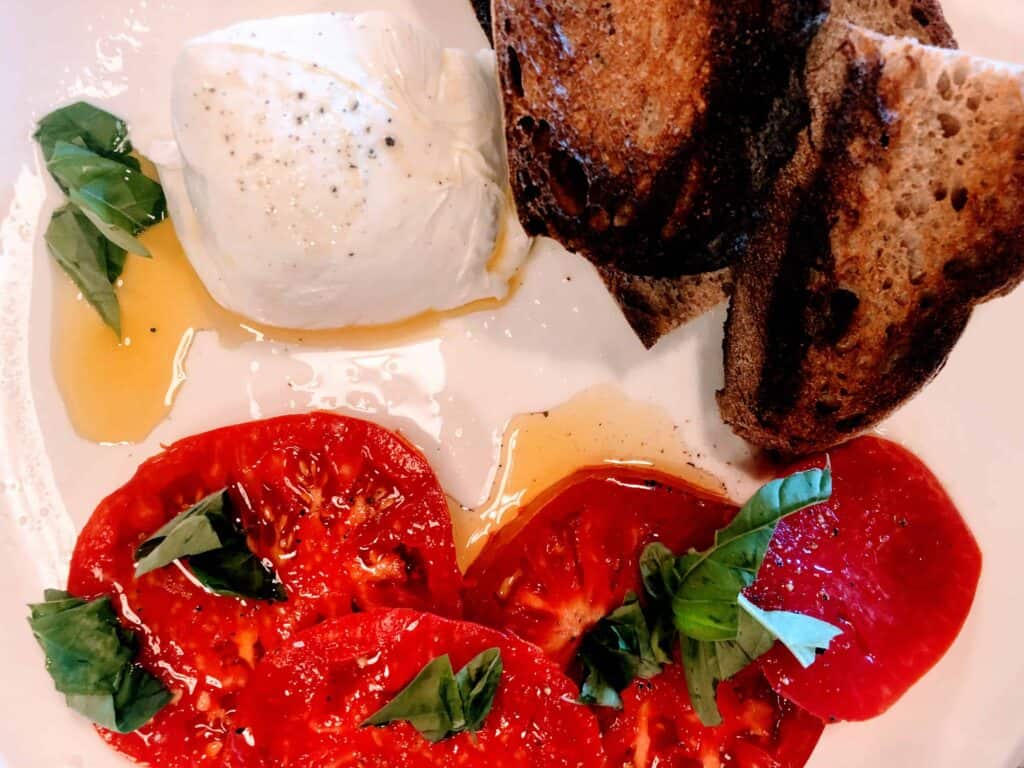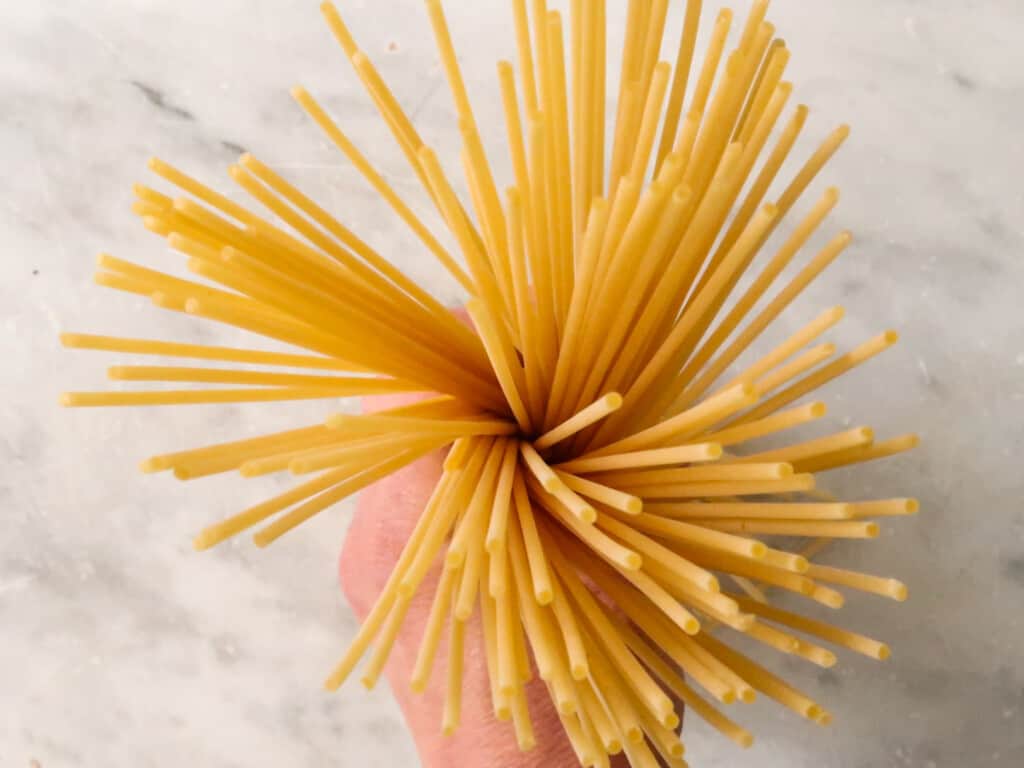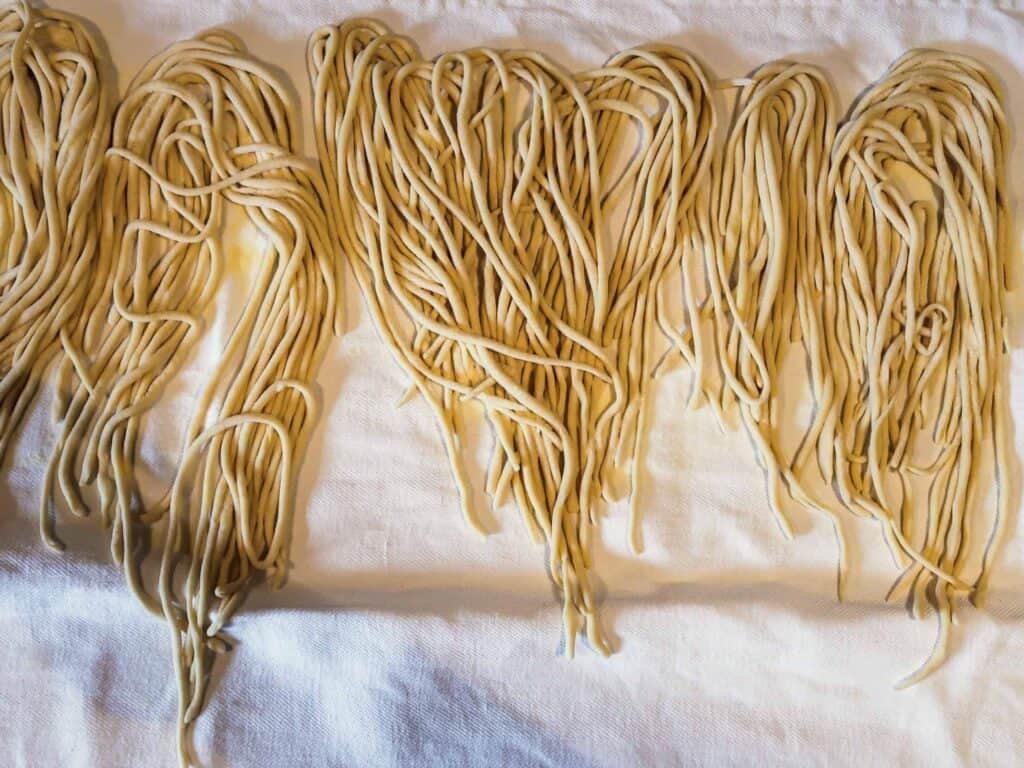Last updated on April 19th, 2024
It’s pretty overwhelming when you’re in Italy standing in front of a case of gelato flavors and there’s a line out the door and the server is staring at you and waiting for you to choose your gelato flavor. There are so many names, colors, textures. How is one to choose?
Italy has so many amazing gelato flavors! We have classics that you’ll find in every gelateria as well as others that are seasonal or trendy.
In this article I’ll demystify all the Italian flavors, making it easier to navigate your next gelato experience, no matter where you are in Italy.
The gelato flavors are organized by major category flavors and types. And if you are worried about botching the pronunciation, I will cover that too with audio for the most popular flavors.
Jump to Section
Authentic Gelato Flavors In Italian
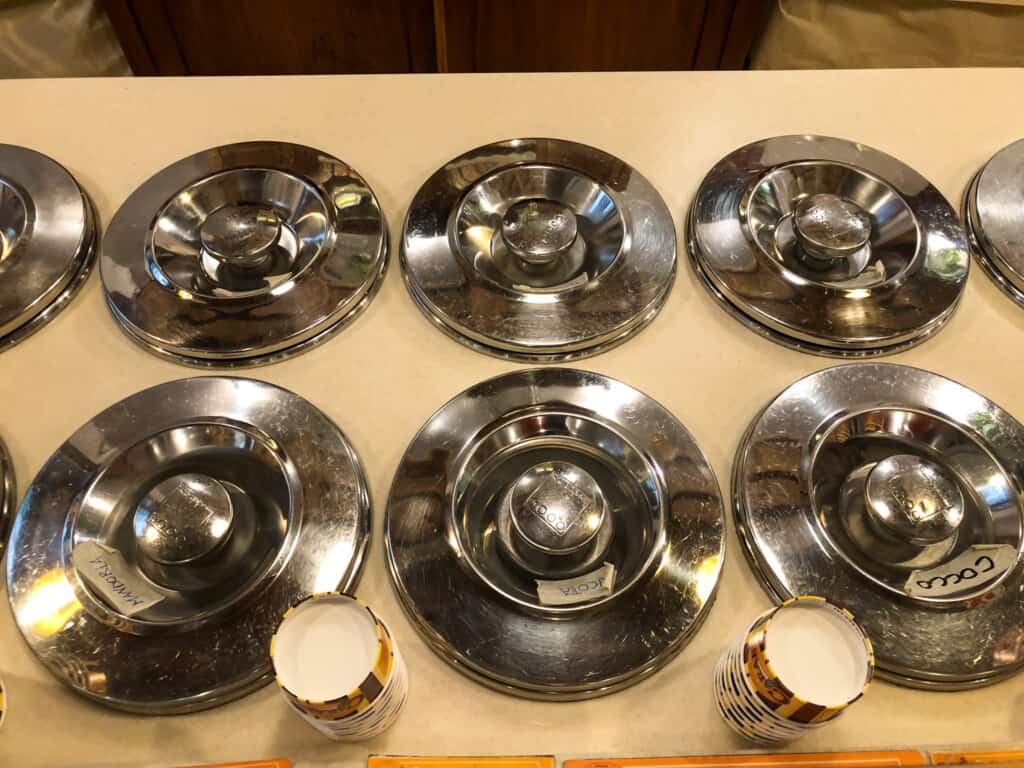
Gelato flavors in Italian is gusti di gelato, pronounced goostee dee geh-lah-toh.
One flavor of gelato is un gusto di gelato (goostoh in Italian)
Listen to gusto di gelato here:
Discovering Daily Gelato Flavors In Italy
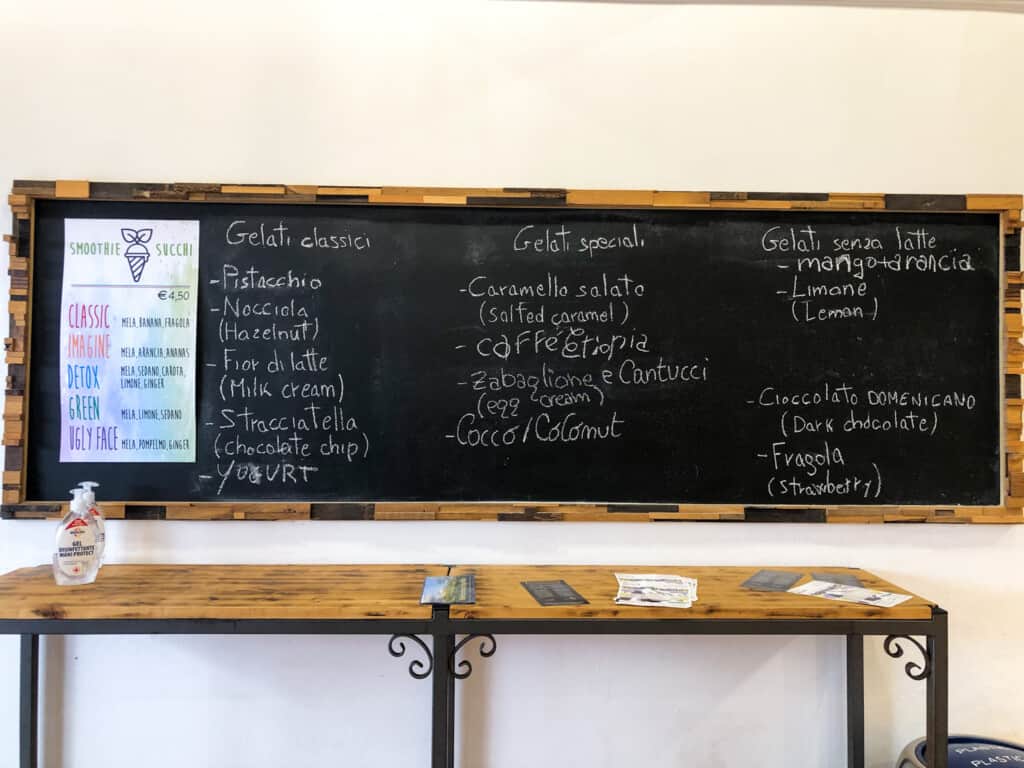
At most artisan gelaterias, the board of gelato flavors will change daily based on what’s in season and what is popular at the time. In more trendy spots, the flavors will be inspired by the gelato-maker’s creativity streek of the day so be prepared for some far-out flavors as well. Read all about the Italian gelato scene in Gelato In Italy – The Scoop on Italy’s Favorite Sweet Treat
Look for either a large board, handwritten sign or small list hanging with the daily flavors. Most likely they will be divided into two categories: gelato flavors and sorbetti or dairy-free flavors (these are most commonly fruit flavors but not always). If you need help ordering gelato in Italian, check out How To Order Gelato In Italy – Step-by-Step Guide + Tips
Tip: Look for trendy, hip flavors in cities with a bit more innovation such as Milan. In my experience, Milan always has the most interesting flavors, followed by Torino and Florence.
Check out my guides to the Best Gelato in Florence and the Best Gelato in Venice!
Chocolate Gelato Flavors In Italy
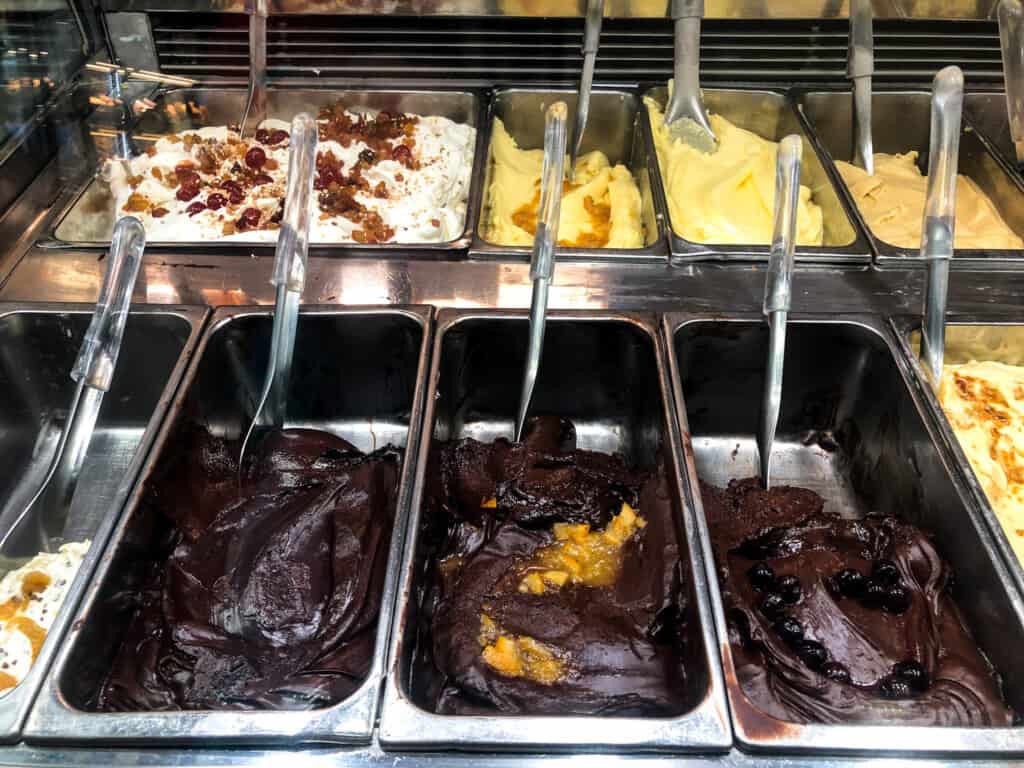
Chocolate gelato or cioccolato as we say in Italian is one of Italy’s favorite flavors but of course, there is not just one type but tens to choose from.
Listen to the pronunciation of cioccolato here:
Gelato al cioccolato comes in many variations depending on the type (dark, milk or in between), the origin of the chocolate and what’s added to it.
A very dark chocolate gelato or gelato al cioccolato fondente, is going to be darker or lighter, richer or lighter, depending on the percentage of actual chocolate or cacao bean used, i.e. 70%, 72%, 80%, 85%. Chocolate flavors may also be identified by their origin such as cioccolato di Ecuador or cioccolato di Venezuela.
Chocolate flavors of gelato are also characterized by what is added to them such as orange, hazelnut or even red chili peppers and cinnamon.
Good To Know: Most chocolate flavors of gelato are milk based but some gelaterias also make a dairy-free chocolate sorbet.
Cioccolato Fondente
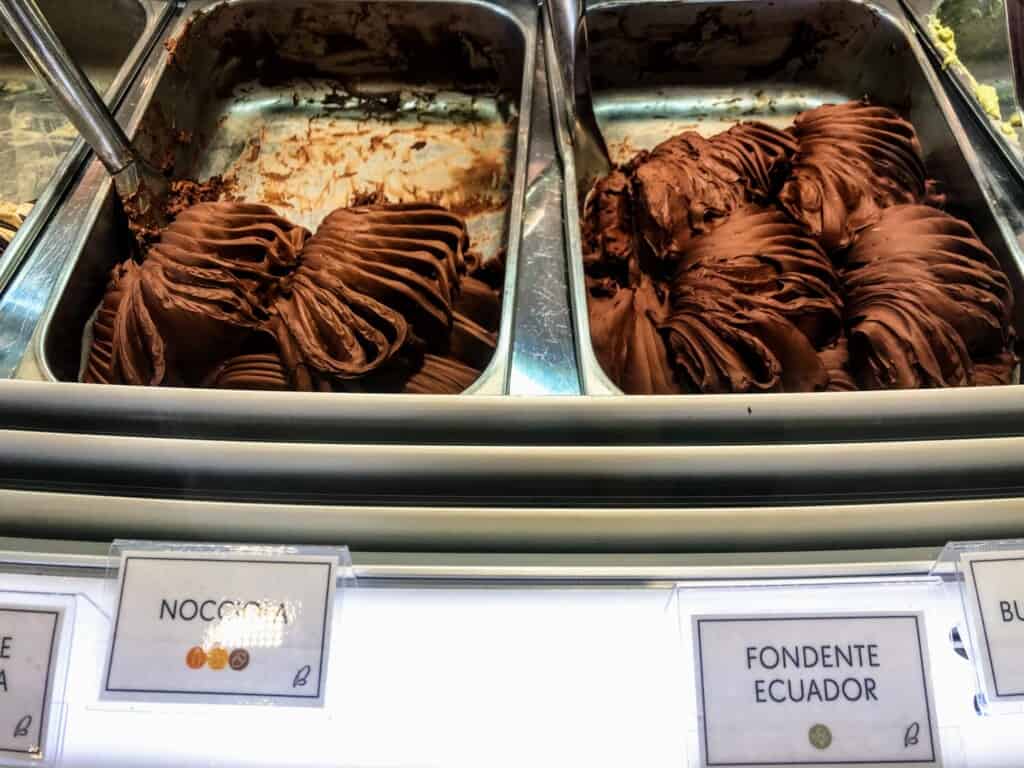
Pronounced cho-koh-lah-toh fon-den-teh in Italian.
Cioccolato fondente is Italy’s dark chocolate gelato that sets itself apart from regular chocolate by its extremely dark, almost black color. Keep your eye out for cioccolato fondente extra noir which is pretty much mostly chocolate and a bit of milk and sugar.
Listen to the pronunciation of cioccolato fondente:
Cioccolato Al Latte
Pronounced cho-koh-lah-toh ahl lah-tay in Italian.
If you aren’t into dark chocolate, there is also a milk chocolate version, much lighter in color, similar to a milk chocolate bar itself.
Cioccolato
Pronounced cho-koh-lah-toh in Italian.
Many gelaterias make a midway gelato between dark and light which is also medium colored brown. It’s not super milky but it clearly caters to everyone’s tastes. It’s the most popular of the three.
Bacio
Pronounced bah-choh in Italian.
Meaning “kiss”, bacio is an ode to Perugina’s famous Bacio chocolate made with chocolate and hazelnuts. Sometimes it has small chunks of hazelnuts, other times, it’s smooth.
Listen to the pronunciation of bacio:
Gianduja or Gianduia
Pronounced jahn-doo-yah in Italian.
Similar to bacio, gianduia is a combination between chocolate and hazelnut but always made with milk chocolate and without the pieces of hazelnuts. Smooth and creamy, this is one of Italy’s most popular gelato flavors
Listen to the pronunciation of gianduia:
Cioccolato All’Arancia
Pronounced cho-koh-lah-toh ahl ah-rahn-chah in Italian.
Chocolate orange, a classic combination, sometimes made with actual bits of candied orange peel and sometimes it’s smooth and creamy.
Listen to the pronunciation of cioccolato all’arancia:
Cioccolato Con Peperoncino
Pronounced cho-koh-lah-toh kohn peh-pehr-ohn-chee-noh in Italian.
Cioccolato con peperoncino is a chocolate base gelato with a hint of spicy hot chili peppers added. It’s just enough to add a zip but not too much to set tasters up for failure.
Cioccolato All’Azteca
Pronounced cho-koh-lah-toh ahl-ahz-teh-kah in Italian.
Cioccolato all’Azteca is an ode to Mexican hot chocolate made with spicy red peppers and a hint of cinnamon.
Cioccolato Bianco
Pronounced cho-koh-lah-toh dee-ahn-koh in Italian.
White chocolate is not very popular in Italy.
Cioccolato Con Zenzero e Pera
Pronounced cho-koh-lah-toh cohn zehn-zehr-oh eh pehr-ah in Italian.
Chocolate with ginger and pear is an Italian gelato flavor that has gained a lot of traction in the past years. Italians and tourists love it.
Ciocolato Con Menta
Pronounced cho-koh-lah-toh kohn men-tah in Italian.
Italians like mint and they like chocolate but together, it’s not a very popular combination which is why you won’t see this flavor very often.
Classic Cream Flavored Gelato In Italy

Cream flavored gelato in Italian represents a category of flavors that are simple, oftentimes used as the bases for other gelato flavors. It’s not exactly fair to call these cream gelato flavors because they are actually made with milk, not cream!
Learn More: If you want to know more about how gelato is made, read Gelato In Italy.
Fiordilatte
Pronounced feeoh-dee-aht-teh in Italian.
Fiordilatte means “flower of the milk” and it’s essentially milk flavored gelato or sometimes described as sweet cream. This is one of Italy’s favorite flavors.
Listen to the pronunciation of fiordilatte:
Fact: Italians say that if you really want to judge a gelateria you should try their fiordilatte or crema because they are so pure. You can really taste the quality of ingredients and attention to detail in these flavors.
Crema
Pronounced kreh-mah in Italian.
Crema translates to cream in English, describing this custard egg-based gelato.
Listen to the pronunciation of crema:
Fact: Unlike most gelato flavors, crema is made with eggs as well as milk.
Caffè
Pronounced kahf-feh in Italian.
Caffè is another popular choice among Italians and tourists. What better way to help pick you up in the afternoon than with a gelato with coffee in it?
Listen to the pronunciation of caffè:
Amarena
Pronounced ah-mah-reh-nah in Italian.
Amarena, originally from Emilia-Romagna is one of the most popular flavors among Italians made with a base of fiordilatte gelato with a generous swirl of sour cherry syrup. Sometimes there are actual sweetened cherries mixed in but no guarantees you will get one in your scoop!
Listen to the pronunciation of amarena:
Stracciatella
Pronounced stratch-chah-tehl-lah in Italian.
Italy’s version of chocolate chip ice cream but made without the chips. Instead, fiordilatte gelato is flavored with chunks of hand cut or shaved dark chocolate. Originally from Piedmont, this gelato flavor is likely to be made in every gelateria throughout Italy.
Listen to the pronunciation of stracciatella:
Buontalenti
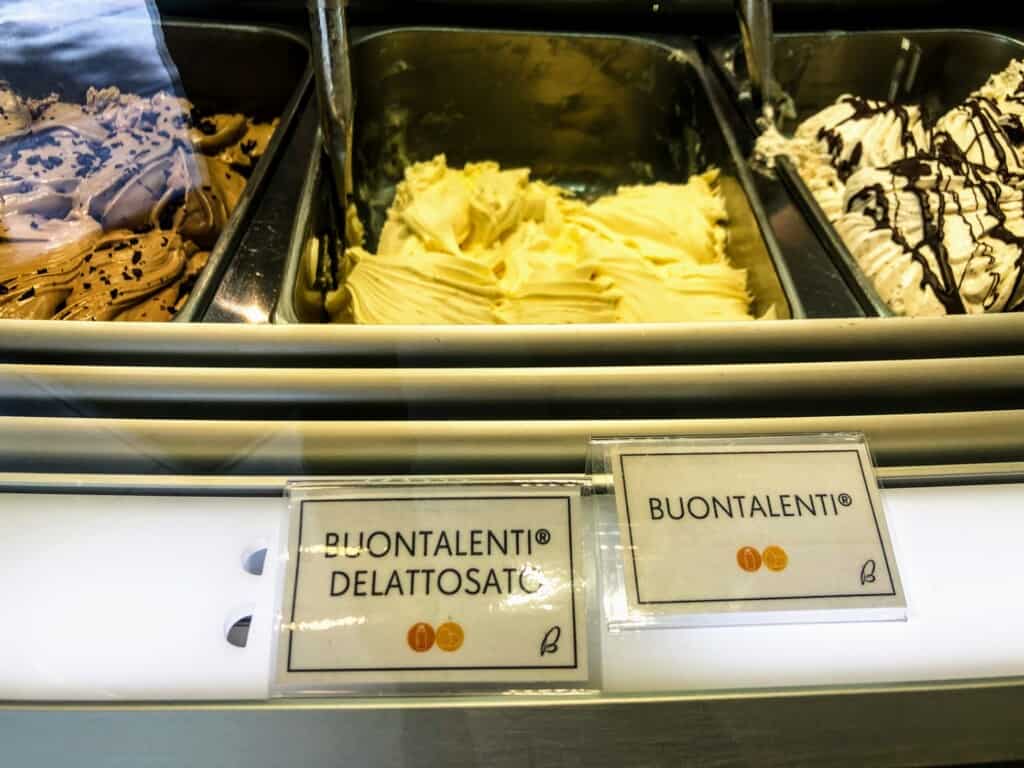
Pronounced bwohn-tah-lehn-tee in Italian.
Named after the famous Italian who discovered the method of freezing milk-based gelato for long periods of time, this creamy, egg-based flavor is named after him, very similar to crema.
Good To Know: Florentines claim that Badiani has the best buontalenti in all of Florence. I cannot vouch for this as I don’t actually order this flavor but I can say Badiani is top of my list!
Vaniglia
Pronounced vah-neel-yah in Italian.
Your classic vanilla that Americans love so much is not quite as popular in Italy. Italians prefer crema any day of the week over vanilla. It’s mostly made for the tourist industry.
Zabaione or Zabaglione
Pronounced zah-bah-yoh-neh / zah-bahl-yoh-neh in Italian.
Zabaione, spelled either way, is an Italian cream dessert similar to a runny pudding made with Marsala wine. This gelato flavor is basically crema with a generous splash of Marsala wine for good measure. It’s one of my favorite ‘egg dishes’ in Italy!
Classic Fruit Flavored Gelato In Italy

Fruit flavors in Italy can either be in the form of gelato (milk-based) or sorbetto (dairy-free). You will be able to tell the difference by looking at the flavors of the day and seeing whether the fruit flavor falls under gelato or sorbetto.
Unlike ice cream flavors, fruit flavored gelato is going to be solid color. The fruit isn’t cut up and mixed into the gelato base but rather, it’s swirled into the milk base, making a uniform and even texture and color.
Fragola
Strawberry gelato, pronounced frah-goh-lah in Italian.
Listen to the pronunciation of fragola:
Limone
Lemon gelato, pronounced lee-moh-neh in Italian.
Listen to the pronunciation of limone:
Frutti di Bosco
Meaning “fruits of the forest”, this is a mixed berry gelato, pronounced froo-tee-dee-boh-skoh in Italian.
Listen to the pronunciation of frutti di bosco:
Susine
Plum gelato, pronounced soo-see-neh in Italian.
Listen to the pronunciation of susine:
Mora
Blackberry gelato, pronounced moh-rah in Italian.
Listen to the pronunciation of mora:
Lampone
Raspberry gelato, pronounced lam-poh-neh in Italian.
Listen to the pronunciation of lampone:
Lime
Lime gelato is quite uncommon, pronounced lime in Italian (same as in English).
Arancia
Arancia gelato, pronounced ah-rahn-chah in Italian.
Tarocco
Blood orange gelato, pronounced tah-rohk-koh in Italian.
Fragolina
Pronounced frah-go-lee-nah in Italian.
Meaning “little strawberry”, this is a gelato flavor made with a tiny variety of strawberries that are only in season in May and June. It’s amazing.
Melone
Melon gelato, pronounced meh-loh-neh in Italian, is a flavor with which gelaterias will play in terms of innovation. You might find spices and herbs added to melon gelato.
Anguria/Cocomero
Watermelon gelato, pronounced an-goo-reeah / coh-coh-mehr-oh in Italian, is a classic summer flavor always made as a sorbet. It’s called cocomero in some parts of Italy but usually referred to as anguria down south.
Pompelmo
Grapefruit gelato, pronounced pohm-pehl-moh in Italian.
Mandarino
Mandarine gelato, pronounced man-dahr-ee-noh in Italian, is one of my favorites in the winter. The best I have ever had is in Gelateria della Passera in Florence.
Pera
Pear gelato, pronounced pehr-ah in Italian, isn’t popular on its own but when combined with flavors such as chocolate, cinnamon or ricotta, it’s much more so.
Mela
Apple gelato, pronounced meh-lah in Italian.
Fico d’India
Prickly pear gelato, pronounced fee-coh deen-dee-ah in Italian, grows well only in southern Italy, which is why you won’t really see it anywhere else but down south.
Fichi
Fig gelato, pronounced fee-kee in Italian.
Cachi
Persimmon gelato, pronounced kah-kee in Italian.
Mirtillo
Blueberry gelato, pronounced meer-teel-loh in Italian.
Kiwi
Kiwi gelato, pronounced kee-wee in Italian.
Ciliegia
Cherry gelato, pronounced chee-lee-eh-jah in Italian. This is just cherry flavored, not amarena.
Gelso
Mulberry gelato, pronounced gel-soh in Italian, is very seasonal and uncommon but very delicious and unique if you can find it!
Melograno
Pomegranate gelato, pronounced meh-loh-grah-noh in Italian.
Pesca
Peach gelato, pronounced peh-skah in Italian.
Albicocca
Apricot gelato, pronounced ahl-bree-cohk-kah in Italian.
Tropical Fruit Flavored Gelato In Italy

Although these aren’t the best flavors to tell a mediocre gelateria from a fantastic one (because all the fruit will come from abroad so the flavor profiles will be similar from one to the next), these are extremely refreshing on a blazing summer day while traveling!
Good To Know: There is no season when it comes to tropical fruits in Italy because they are always imported. Get them whenever!
Mango
Mango gelato, pronounced mahn-goh in Italian. This gelato flavor will never be made with domestic mango but it’s still very refreshing.
Banana
Banana gelato, pronounced bah-nah-nah in Italian, can be very good. As per gelato rules, it’s made with no fake banana flavoring so you can really taste the actual fruit. The color should also reflect the real fruit: a pale, cream color. Run from brightly yellow colored gelato!
Cocco
Coconut gelato, pronounced cohk-koh in Italian, is sometimes dairy-free but more often than not it’s made with a milk base.
Frutto Della Passione
Passion fruit gelato, pronounced froot-toh dehl-lah pas-syoh-neh in Italian, is another popular tropical summer flavor to take the edge off.
Ananas
Pineapple gelato, pronounced ahn-ahn-ahs in Italian.
When To Eat Fruit Flavored Gelato In Italy

The best fruit flavored are seasonal and you will only be able to taste what is in season at the moment. For example, citrus fruit flavored gelati are made in the winter while flavors like peach, apricot and watermelon are summer favorites.
When choosing fruit flavors, I suggest you go with what is in season. You can always ask the gelateria for their top pick but you can also reference this list below:
| Month | Seasonal Fruit In Italy |
| January | mandarin orange, orange, grapefruit, kiwi, pear, pomegranate, persimmon, apple |
| February | mandarin orange, orange, grapefruit, pear, kiwi, apple, lemon |
| March | pear, lemon, orange, mandarin orange, grapefruit, kiwi, apple |
| April | strawberry, lemon, orange, mandarin orange, kiwi, apple, pear |
| May | Apricot, cherry, strawberry, kiwi, orange, pear |
| June | apricot, cherry, fig, strawberry, raspberry, kiwi, melon, blueberry, pear, peach, plum |
| July | peach, apricot, watermelon, kiwi, pear, cherry, melon, raspberry, blueberry, plum |
| August | kiwi, pear, prune, melon, apricot, peach, watermelon, fig |
| September | plum, melon, peach, fig, prickly pear, watermelon, pomegranate, lemon, lime, raspberry |
| October | pear, raspberry, fig, persimmon, apple, prickly pear |
| November | pear, apple, prickly pear, pomegranate, persimmon |
| December | mandarin orange, orange, pear, kiwi, pomegranate, persimmon, grapefruit, lemon |
Nut Flavored Gelato In Italy

Nut flavors are by far some of the most beloved gelato flavors in Italy. You will often see them stand alone and this is how I recommend trying them but they are also mixed with chocolate or custard flavors.
The gelateria is good when you can taste that the nuts actually taste like nuts. You can also look at the color of these gelato flavors. They should be dull and muted, not brightly colored which can only be achieved by adding additional colors.
Learn more about how to tell a good gelateria from a bad one in Gelato in Italy.
Nice To Know: Peanuts aren’t really a big thing in Italy. The only time Italians really eat them is during aperitivo. Some gelaterias do make gelato di arachidi (peanut flavored gelato) on rotation to cater to tourism but it’s not one of those flavors you will see everyday.
Mandorla
Pronounced mahn-dohr-lah in Italian.
Mandorla comes as a gelato or as sorbetto but either way it’s amazing. It doesn’t really taste like marzipan but rather, just pure nuttyness with a hint of sugar!
Listen to the pronunciation of mandorla:
Pistacchio
Pronounced pee-stahk-keeoh in Italian.
Pistacchio is THE flavor you want to check out in terms of color to tell if a gelateria is good or not. The color should be a pale, muted, sage green, not a bright pea green.
The absolute best pistacchio gelato is made with pistachios di Bronte DOP
Listen to the pronunciation of pistacchio:
Nocciola
Pronounced nohch-chyoh-lah in Italian.
Nocciola is definitely one of Italy’s most favorite flavors. Italians often order it with chocolate for the perfect duo.
Listen to the pronunciation of nocciola:
Castagna
Pronounced cah-stahn-yah in Italian.
Chestnut gelato is often paired with other ingredients. You will also see it sold as Marron glacé (pronounced mahr-rohn glah-seh in Italian), made with candied chestnuts.
Pinoli
Pine nut gelato, pronounced pee-noh-lee in Italian, isn’t super common and when you see it, it’s likely to be mixed with other flavors.
Noce
Walnut gelato, pronounced noh-cheh in Italian, is often made with other ingredients such as honey or yogurt.
When To Eat Nut Flavored Gelato In Italy
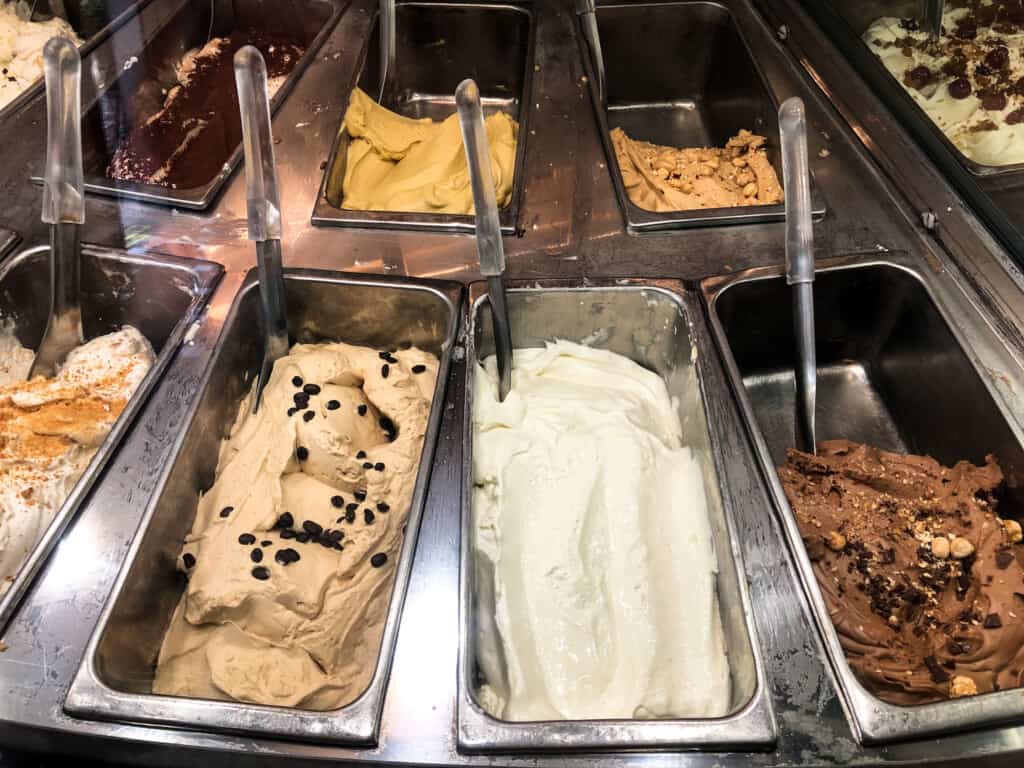
While you will be able to find the most popular nut flavored gelato year-round, nuts also have seasons in Italy and the best gelaterias will be using locally harvested nuts of that year’s crop in these months.
| Nut | When It’s In Season |
| Chestnut | October-December |
| Almond | Fall |
| Pistachio | Fall |
| Hazelnut | August-October |
| Walnut | September-December |
| Pine Nut | October-April |
Cake And Cookie Flavored Gelato In Italy
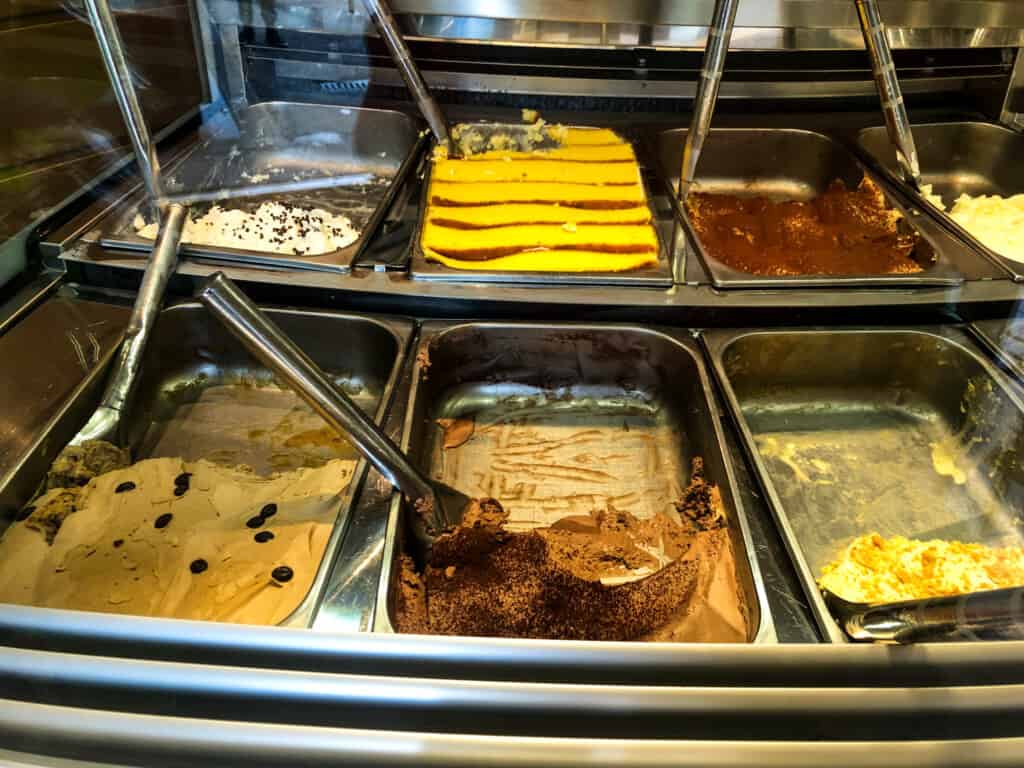
The number of gelato flavors that incorporate their love for cookies and cakes is much longer than expected. Gluten-free travelers beware of these flavors!
If you’re celiac or gluten free, read Is Italian Gelato Gluten Free?
Cookies/Biscotti
Pronounced Cook-ees/bee-skoht-tee in Italian.
Basically gelato ai cookies or gelato ai biscotti is a cream gelato with crunched up cookies inside. The cookies can vary but they are usually simple butter cookies with or without chocolate.
Listen to the pronunciation of cookies:
Tiramisù
Pronounced tee-rah-mee-soo in Italian.
Obviously, this flavor is based off of one of Italy’s most famous desserts, tiramisù, made with eggs, mascarpone and coffee.
Listen to the pronunciation of tiramisù:
Panettone
Pronounced pahn-eht-toh-neh in Italian.
A typical Italian Christmas cake with raisins and candied fruits that is incorporated into a cream gelato during the holiday months.
Baci Di Dama
Pronounced bah-chee dee dah-mah in Italian.
An amazing cream based gelato with bits of hazelnut cookies and chocolate. Every gelateria does it differently (some with chunks of chocolate, others with a swirl of hazelnut spread, most always with broken-up cookies) but the result is always delicious.
Crostata ricotta e visciole
Pronounced Croh-stah-tah ree-coht-tah eh vee-shyoh-leh in Italian.
A Roman shortcrust pie with sour cherries and ricotta made into a decadent gelato flavor usually found in Rome or in Lazio.
After Eight
Pronounced ahf-tehr ayt in Italian.
This is another flavor that is made differently by each gelateria but cookies and mint will always be the base.
Cassata siciliana
Pronounced cahs-sah-tah see-shee-lee-ah-nah in Italian
Sicily’s most famous cake, cassata siciliana, decorated with candied fruits makes its way into this fiordilatte gelato base.
Torrone
Pronounced tohr-roh-neh in Italian.
Torrone isn’t necessarily going to have gluten in it so just ask. It’s made with honey, sugar and nuts, just like nougat.
Foresta Nera
Pronounced for-eh-stah neh-rah in Italian.
Foresta nera or black forest is made from chocolate, cream and cherries. It may or may not have bits of cake in it so ask if you are gluten-free.
Zuppa Inglese
Pronounced zoop-pah in-gleh-seh in Italian.
Meaning “English soup” this gelato flavor is inspired by the famous Italian dessert made with sponge cake or Italian savoiardi cookies and custard. Sometimes it will be flavored with sweet wine and have actual bits of sponge cake in the gelato.
Cantucci/Cantuccini
Pronounced Can-tooch-chee/can-tooch-chee-nee in Italian.
Cantuccini gelato is a cream gelato flavored with vin santo wine and crunchy almond cookies from Tuscany.
Cheesecake
Pronounced cheez-cayk in Italian.
A classic creme based gelato with a cheesecake flavor sometimes with the addition of berries, chocolate or caramel.
Unexpected Gelato Flavors In Italy
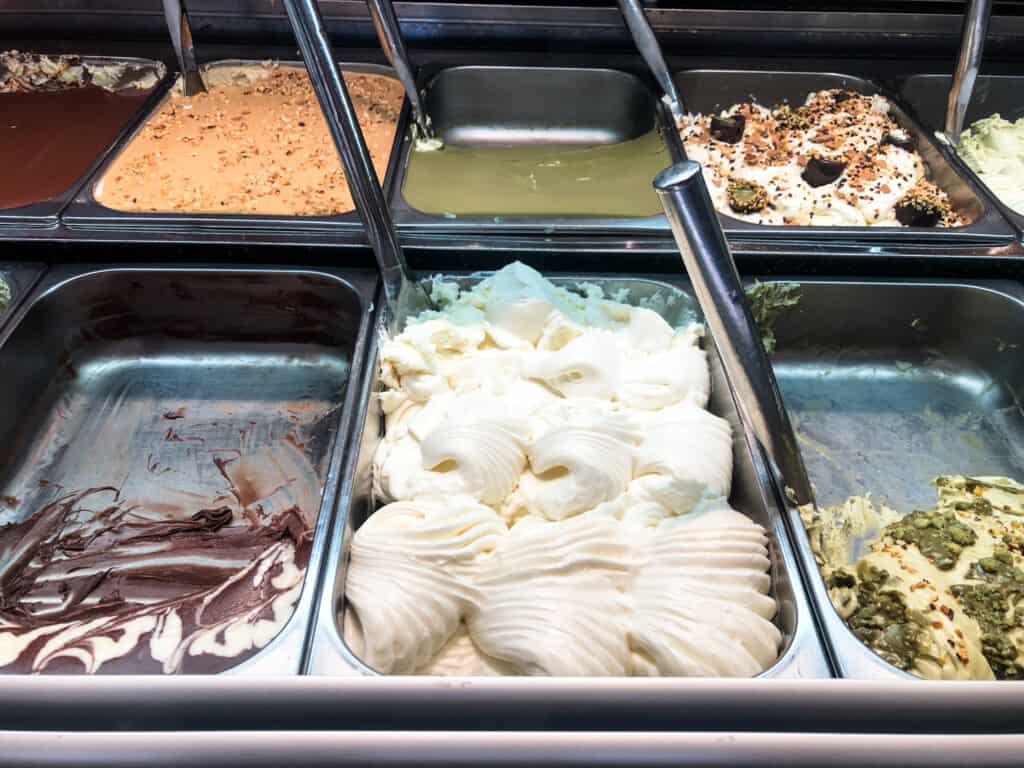
Here is a list of the most unexpected and strange gelato flavors you will come across while in Italy. They aren’t all weird but just kind of unheard of for a tourist.
Riso
Pronounced ree-soh in Italian.
Riso is a rice-pudding gelato made with the classic creamy milk-base with bits of rice cooked into it. I love it because it adds texture to a seemingly uninteresting flavor.
Listen to the pronunciation of riso:
Yogurt
Pronounced yo-goort in Italian.
Yogurt is a semi-sour gelato that strangely enough, resembles the tangy flavor of yogurt. I love this flavor because it adds a bit of contrast to very strong flavors such as dark chocolate. The best I have ever had is at Badiani (Florence).
Listen to the pronunciation of yogurt:
Ricotta
Pronounced ree-coht-tah in Italian.
You won’t always find ricotta gelato on its own but more commonly paired with things like pear or apple.
Listen to the pronunciation of ricotta:
Caramello (Salato)
Pronounced cahr-ah-mehl-loh (sah-lah-toh) in Italian.
Caramel flavored gelato has made its way into the mouths of Italians and they love it, especially if it’s salato or salted.
Sambuco
Pronounced sahm-boo-coh in Italian.
Sambuco is elderflower gelato which is often combined with nuts. Look for this in Northern Italy where Sambuco grows wild in the mountains.
Mascarpone
Pronounced mahs-cahr-poh-neh in Italian.
Mascarpone gelato will commonly be made with other flavors such as figs, raisins or nuts.
Menta
Pronounced mehn-tah in Italian.
A green mint gelato – not my favorite and not a favorite among Italians. Kids like it though.
Liquirizia
Pronounced lee-kweer-ee-zee-ah in Italian.
Liquirizia is not your red licorice but rather, black licorice with a strong and defined flavor. It’s made palatable and sweet with sugar but it’s certainly not for everyone.
Cannella
Pronounced cahn-nehl-lah in Italian.
Don’t expect a spicy or hot version. Instead, it’s delicate but bold, with a strong, sweet cinnamon flavor. Look for it paired with other flavors such as nuts, ricotta and chocolate.
Puffo
Pronounced poof-foh in Italian.
Smurfs in Italian are known as puffi and this gelato is named after their bright blue characters. The flavors vary from gelateria to gelateria but it’s definitely going to be an artificial flavor so don’t expect to find it in good places. I refuse to let my children order this so I have actually never tried it.
Unicorno

Pronounced oo-nee-cohr-noh in Italian.
Unicorno is another flavor I refuse to let my kids order. It’s basically a rainbow gelato flavored artificially with something like various fruits or bubble gum. Again, not something to look for in a good place. If you see it, try another gelateria.
Gelato Flavors Made With Liqueur

Here is a quick rundown of flavors made with liqueur. They aren’t super boozy but you can definitely taste them!
- Crema al Whiskey
- Crema al Marsala
- Crema allo Strega Liqueur – herb infused liqueur gelato
- Crema al Cognac
- Crema all’amaretto – this can refer to either the almond cookie or almond liqueur.
- Malaga – rum raisin, actually quite popular among Italians
Italian Gelato Flavors – Printable Quick Guide
Print off this ‘cheat sheet’ with 80+ gelato flavors and their English translations and pronunciations. Just click on the photo or here to open up a new tab with a print-quality PDF.
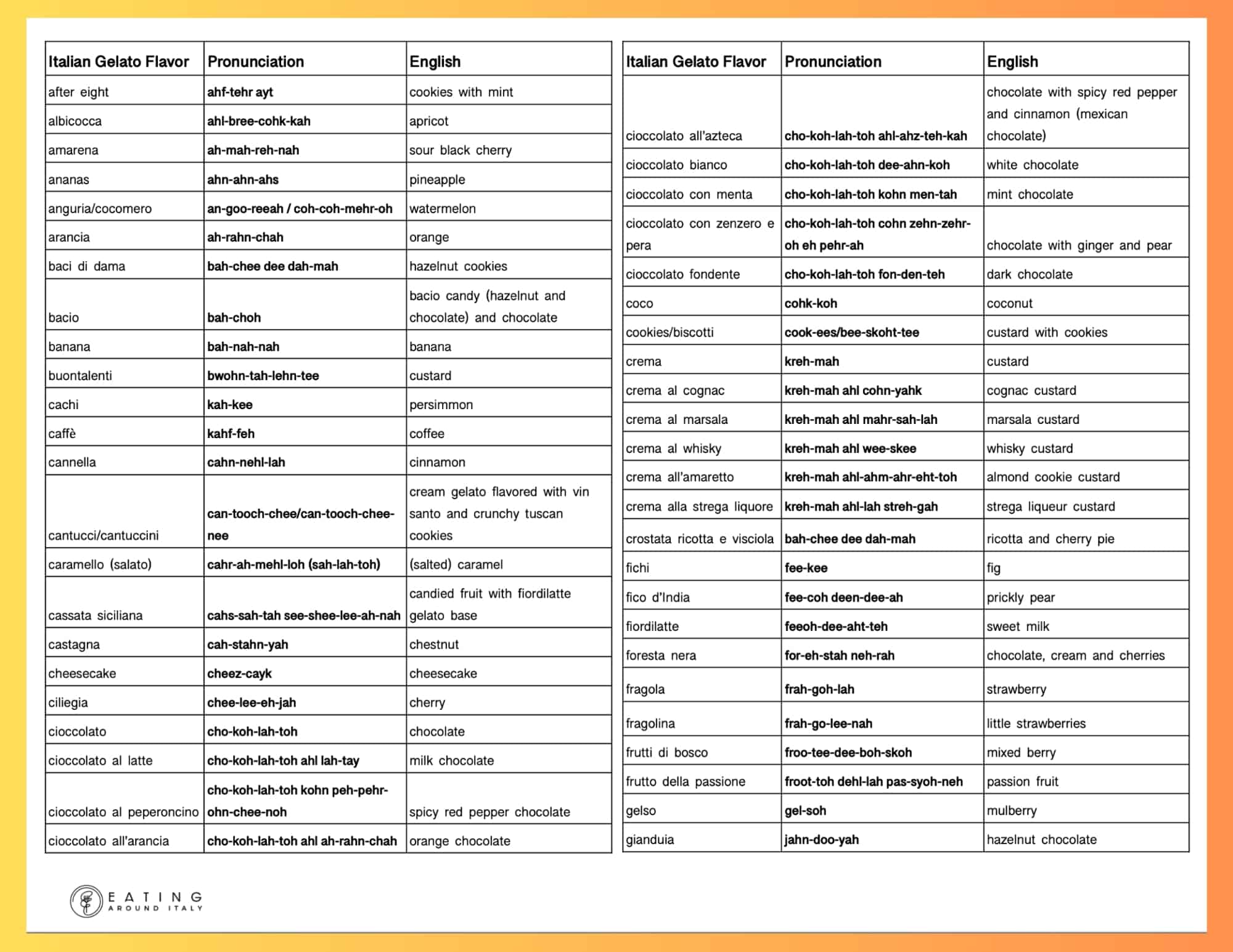
Gelato Flavor Terms To Know In Italy
Here are some common terms you will see on gelato flavor labels in Italy that help to describe the type of gelato. Familiarize yourself with these gelato flavor terms for easier gelato flavor navigation!
- Variegato – meaning “multi-colored”, this term is used to describe a gelato with various flavors that you can actually see within the gelato (they are not hidden to the eye such as gianduia in which you can’t actually see the hazelnut).
- Cremolato – This isn’t exactly a gelato but rather, a sort of icey that is served in a cup and eaten with a spoon. It’s made with a lot of fruit so it tends to be quite creamy, rather than icy.
- Croccante – meaning brittle, this will mean that there is going to be part of the gelato that is a bit crunchy. Whether it be the topping or bits that are mixed in, expect to chew your ice cream with this term!
- Senza zucchero – These are flavors that don’t use added sugar. They may be sweetened with sugar imposters but not always. For example, Badiani in Florence makes a yogurt senza zucchero that is just naturally a little bit sweet and very tangy.
- Vegano – meaning vegan, you may see this listed on the gelato flavor board as a category with various flavors under it. It’s basically referring to sorbets.
Learn More: Read about the Difference Between Gelato and Ice Cream (& Other Italian Frozen Treats).
Italian Gelato Flavors FAQ
The most popular flavors of gelato in Italy are cioccolato (chocolate), crema (crema), fiordilatte (sweet milk) and nocciola (hazelnut).
Florence is the best known city for gelato because Buontalenti is credited with the invention of gelato.
Brightly colored gelato should be avoided because it means there are added colors. The best authentic gelato is all-natural without any coloring, additives or preservatives.
Gelato is better in Italy because it’s slow churned and made with all natural ingredients, creating a creamy and smooth frozen treat.
Gelato is considered healthier than ice cream because it has a lower fat content. Gelato has only about 4 to 8 percent milkfat while ice cream has around 14 perfect milk fat.
Italy has the best gelato in the world, specifically Florence, where gelato was first invented.

